Many health “consultants” say you need to squat to construct robust, outlined legs.
Not true.
The squat is a wonderful train, but when accidents stop you from squatting accurately or comfortably, or squats simply aren’t your bag, there are many good barbell again squat options for constructing lower-body muscle and power.
On this article, you’ll be taught 9 of the perfect options to squats, why they’re efficient, and learn how to do them with correct kind.
Key Takeaways
- The squat is efficient, nevertheless it’s not the one technique to construct robust legs. If in case you have joint ache, accidents, or desire different workout routines, there are many stable squat variouss.
- The very best squat variouss are simple to carry out and scale back stress on the backbone, knees, and different joints, offering a extra easy and comfy choice for individuals who discover conventional again squats tough or painful.
- Extremely efficient options to the barbell again squat embody the entrance squat, leg press, Bulgarian break up squat, step-up, lunge, trap-bar deadlift, Romanian deadlift, belt squat, and goblet squat.
Why Use Barbell Squat Alternate options?
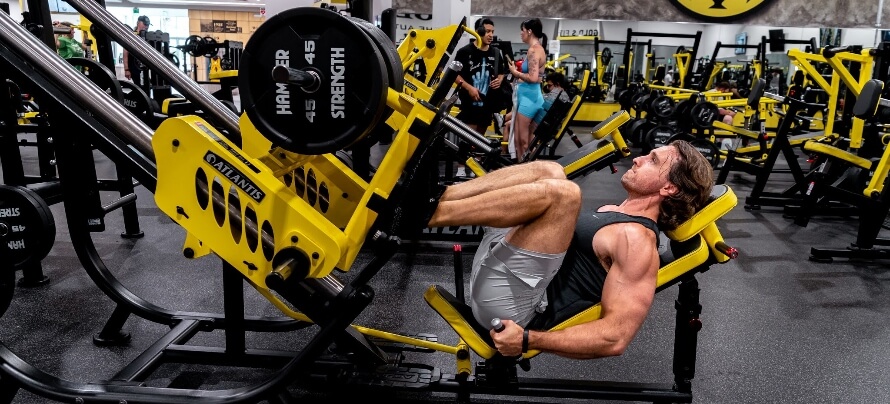

Most consultants take into account the barbell again squat the “king of workout routines” as a result of no different motion trains as many muscle tissue all through the physique. It additionally enables you to carry heavy weights safely and progress repeatedly, so it’s best for gaining muscle and power.
That mentioned, not everybody can or desires to barbell again squat.
For instance, these with decrease again issues could discover placing weight on their backbone uncomfortable. Equally, individuals with knee points could discover it tough to bend their knees to 90 levels and past. In each instances, barbell again squats in all probability aren’t the perfect answer.
Barbell again squatting isn’t at all times best for rookies, both. Some discover the approach powerful to grasp, whereas others wrestle to carry a 45-pound bar—the minimal required to carry out a barbell again squat.
Then there are those that merely don’t take pleasure in again squats and like different leg workout routines as a substitute.
And that’s the place barbell again squat options are available in.
The very best various squat workout routines scale back stress in your joints, providing a extra comfy choice for individuals who discover again squats uncomfortable. Additionally they are typically less complicated, in order that they’re extra accessible than again squats.
Good squat options usually really feel distinct sufficient from the again squat to be extra palatable for individuals who dislike the train, too.
And crucially, they do all this with out sacrificing muscle or power features.
In different phrases, the perfect barbell again squat options allow you to construct measurement and power with none of the downsides of barbell again squatting.
The 9 Greatest Barbell Again Squat Alternate options
Listed here are my 9 favourite options to the barbell again squat.
These workout routines are nice substitutes as a result of they practice all the identical muscle tissue in your decrease physique—particularly the quads, hamstrings, and glutes—together with different main muscle teams just like the decrease again, calves, and core.
If barbell squats really feel like a wrestle, strive incorporating a few of these options into your routine. You’ll get all of the features with out the grief.
1. Entrance Squat
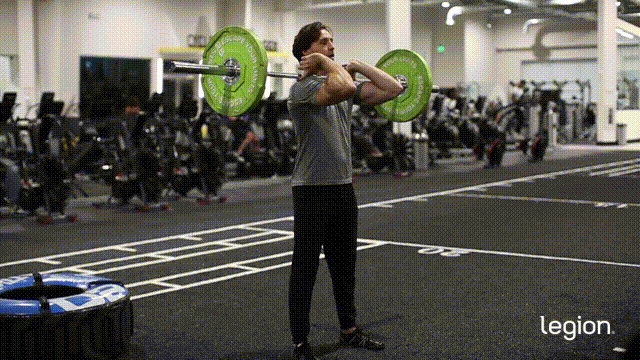

Why: The entrance squat is most consultants’ go-to barbell again squat various as a result of it trains the quads as successfully because the again squat, even if you use as much as 20% much less weight. It additionally locations much less compressive forces in your knees and decrease again, so it’s extra comfy for individuals who have knee or again points.
If, after a number of weeks of making an attempt, you discover the entrance squat “rack place” painful in your shoulders and wrists, take into account switching to a “cross-arm” grip, or substitute the entrance squat for an train that trains your physique equally, such because the Zercher squat or hack squat.
Learn how to:
- Place the barbell in a squat rack at in regards to the peak of your breastbone.
- Grip the bar together with your palms shoulder-width aside, palms dealing with away from you.
- Step nearer to the bar, so it rests in your higher chest, and lift your elbows in entrance of the bar.
- Raise the bar out of the rack, take 1-to-2 steps again, and place your toes barely wider than shoulder-width, toes turned barely out.
- Sit down, holding your again straight, elbows up, and knees in step with your toes.
- Stand again up and return to the beginning place.
READ MORE: Learn how to Entrance Squat: Type, Advantages & Alternate options
2. Leg Press
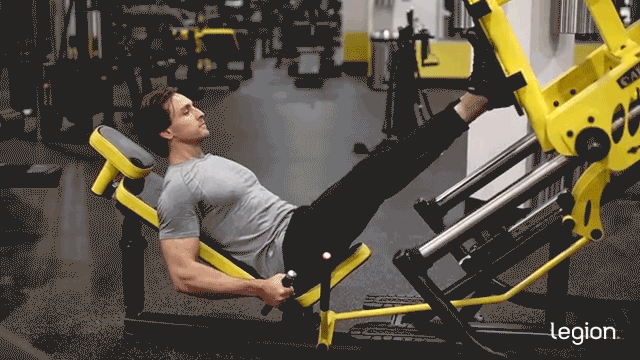

Why: The leg press is a wonderful various to barbell squats as a result of it trains all the identical decrease physique muscle tissue, however doesn’t require you to steadiness or assist weight together with your higher physique and permits you to practice with heavier masses in comparison with free-weight leg workout routines.
This implies it’s excellent for gaining mass and power, whereas being a lot gentler in your joints and comfortable tissues.
Learn how to:
- Load the leg press machine with plates.
- Sit within the seat and wedge your butt down into the bottom.
- Place your toes midway up the footplate, barely wider than shoulder-width, with toes pointing barely out.
- Straighten your knees and use the security handles to launch the burden.
- Decrease the footplate towards your chest, holding your again straight and thighs about 10-to-12 inches out of your chest.
- Reverse the motion and return to the beginning place.
READ MORE: Learn how to Do the Leg Press: Advantages, Type, & Alternate options
3. Bulgarian Break up Squat


Why: The Bulgarian break up squat is a top-tier barbell again squat various as a result of it trains your whole decrease physique one leg at a time, so it’s nice for locating and fixing muscle imbalances and will even enhance athletic efficiency greater than barbell squats.
Learn how to:
- Maintain a dumbbell in every hand and stand 2-to-3 toes in entrance of a bench, together with your again to it.
- Place your left foot on the bench behind you, holding your proper foot and heel firmly planted.
- Decrease your physique by bending your proper knee, bringing your proper thigh parallel to the ground.
- Stand again up and return to the beginning place.
READ MORE: Learn how to Carry out Bulgarian Break up Squats for Glutes, Hamstrings & Quad Development
4. Step-Up
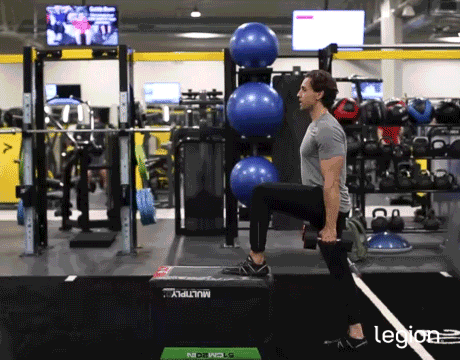

Why: The step-up is a first-rate barbell squat substitute as a result of it trains your whole decrease physique, together with your quads, glutes, and hamstrings. And because it doesn’t require you to carry heavy weights to be efficient, it’s kinder to your bones and joints.
Furthermore, analysis reveals that the dumbbell step-up is a implausible “accent” train to the squat—it lets you achieve muscle and power that reinforces your squat efficiency with out putting practically as a lot pressure in your physique.
Learn how to:
- Maintain a dumbbell in every hand and place your left foot on a sturdy floor about knee-height off the ground.
- Preserve your weight in your left foot and totally straighten your left leg.
- Decrease your proper foot towards the ground and return to the beginning place.
READ MORE: Weighted Step-Ups Information: Learn how to Do Dumbbell Step-Ups
5. Lunge
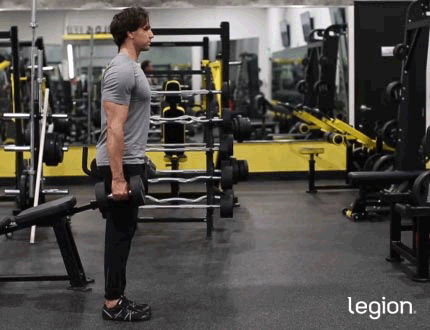

Why: The dumbbell lunge trains all your lower-body muscle tissue and, as a result of it’s a dynamic train that requires extra steadiness and coordination than most leg workout routines, it additionally engages smaller stabilizer muscle tissue all through your physique.
Learn how to:
- Maintain a dumbbell in every hand and stand with toes hip-width aside.
- Take a protracted step ahead together with your proper foot, about 2-to-3 toes.
- With most of your weight in your proper leg, decrease your physique till your left knee touches the ground.
- Push off the ground together with your proper foot and lean barely again, straightening your legs.
- As soon as standing, deliver your proper foot again to the beginning place.
READ MORE: Learn how to Lunge: Type, Advantages, and Variations
6. Entice-Bar Deadlift
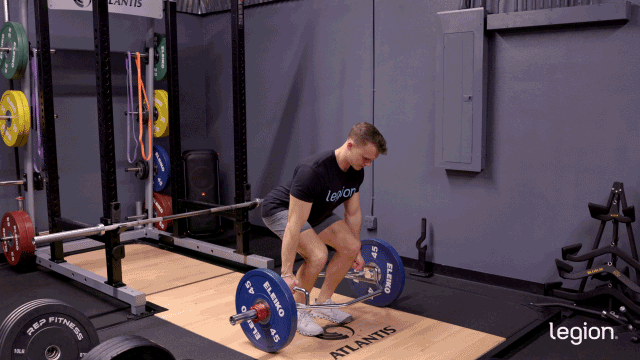

Why: The trap-bar deadlift engages the quads considerably greater than different deadlift variations, and it trains the decrease again and glutes to a excessive diploma, making it probably the most related deadlift to the squat and a viable squat various.
Learn how to:
- Place your toes shoulder-width aside within the heart of the lure bar.
- Hinge at your hips, barely arch your decrease again, and grip the handles.
- Push by your heels to drive your physique upward and barely again.
- Reverse the motion and return and the beginning place.
READ MORE: Learn how to Entice-Bar Deadlift with Correct Type (with a Free 12-Week Coaching Plan!)
7. Romanian Deadlift
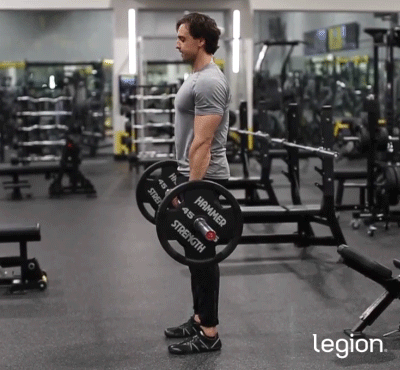

Why: The Romanian deadlift is a wonderful again squat various for creating the posterior chain (the muscle tissue on the again of your physique), particularly the glutes, hamstrings, and decrease again muscle tissue.
If the Romanian deadlift bothers your decrease again, however you need to develop your hamstrings, strive the leg curl as a substitute.
Learn how to:
- Stand holding a barbell with a shoulder-width overhand grip (palms dealing with you).
- Hinge at your hips, holding your again flat, and decrease the bar in a straight line, letting your hips transfer backward.
- While you really feel a stretch in your hamstrings, bend your knees barely and hold reducing the barbell till your again begins to spherical.
- Reverse the motion and return to the beginning place.
READ MORE: Learn how to Do the Romanian Deadlift: Type, Advantages, and Variations
8. Belt Squat


Why: The belt squat is a steady train that permits you to squat heavy weights with out loading your backbone. As such, it’s usually much less fatiguing and simpler to recuperate from than barbell squatting, so you are able to do it extra typically with out carrying your self out.
Learn how to:
- Stand on the platform dealing with the machine and loop the belt round your waist.
- Squat right down to hook the belt to the machine, then place your toes wider than shoulder-width, with toes pointing barely out.
- Seize the machine deal with with each palms, straighten your legs to carry the burden, and pull the deal with to launch it.
- Maintaining your again straight, sit down and push your knees out in step with your toes.
- Rise up and return to the beginning place.
READ MORE: Learn how to Belt Squat for Quad Power & Mass
9. Goblet Squat
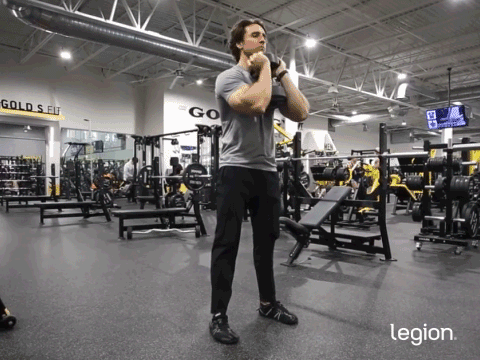

Why: The goblet squat is an efficient train for coaching your lower-body muscle tissue, significantly your quads. Since you maintain the burden in your palms relatively than throughout your shoulders, it’s additionally simpler in your again than different squat variations.
What’s extra, the goblet squat permits you to apply squatting with gentle weights for prime reps, making it best for rookies. And because it requires little gear and area, it’s additionally an excellent barbell squat various for at-home exercises.
Learn how to:
- Maintain a dumbbell in entrance of your chest with each palms.
- Place your toes barely wider than shoulder-width aside, level your toes out to the aspect at a few 45-degree angle, elevate your chest, and sit down.
- Keep in mind to maintain your again straight and push your knees out in the identical path as your toes all through every rep.
- Rise up and return to the beginning place.
READ MORE: Goblet Squat: Type, Type, Muscular tissues Labored, & Frequent Errors
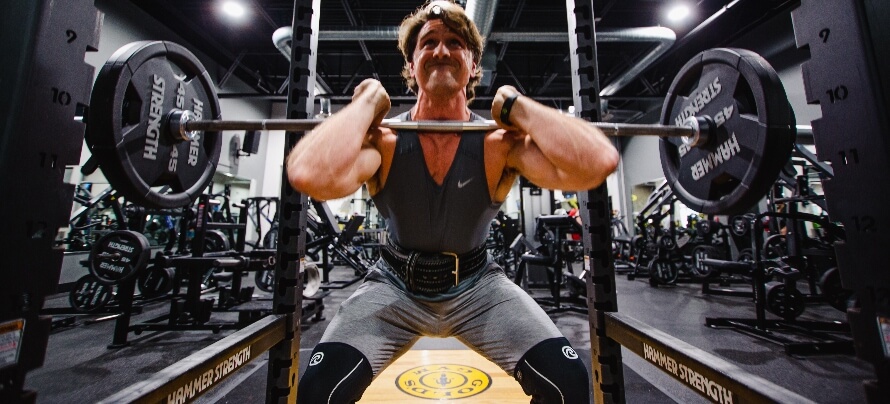

FAQ #1: What’s the finest various to squats?
There’s no single “finest” squat various—it actually is determined by your objectives and circumstances. For example, the perfect squat options for at-home exercises are typically dumbbell workout routines just like the Bulgarian break up squat, lunge, or goblet squat since these workout routines require the least gear and area.
Nevertheless, if you need an various for gaining most mass and power, an train that permits you to carry heavy weights safely and progress repeatedly will probably be higher. On this case, the entrance squat, leg press, or belt squat can be extra becoming.
FAQ #2: Can I construct legs with out squats?
Sure, you’ll be able to construct spectacular legs with out ever squatting. Whereas squats are an impressive train for gaining decrease physique mass, the options mentioned above will give related outcomes.
FAQ #3: What are the perfect at-home barbell again squat options?
The very best barbell squat options for at-home coaching are the Bulgarian break up squat, step-up, lunge, dumbbell Romanian deadlift, and goblet squat. These workout routines solely require dumbbells, making them best for dwelling exercises the place barbells or machines aren’t out there.
When you don’t have any gear, you’ll be able to nonetheless construct leg mass and power with body weight options just like the body weight squat, pistol squat, and sissy squat. Simply keep in mind that to proceed gaining measurement and power, you need to problem your muscle tissue with progressively heavier weights over time.
In different phrases, whereas these body weight squats may work initially, you’ll doubtless should get some dumbbells or bands to proceed making features.
RELATED: What Is Progressive Overload Coaching?
Scientific References +
- Yavuz, Hasan Ulas, et al. “Kinematic and EMG Actions throughout Entrance and Again Squat Variations in Most Masses.” Journal of Sports activities Sciences, vol. 33, no. 10, 29 Jan. 2015, pp. 1058–1066, www.growkudos.com/publications/10.1080percent25252F02640414.2014.984240/reader, https://doi.org/10.1080/02640414.2014.984240.
- Gullett, Jonathan C, et al. “A Biomechanical Comparability of Again and Entrance Squats in Wholesome Skilled People.” Journal of Power and Conditioning Analysis, vol. 23, no. 1, Jan. 2009, pp. 284–292, journals.lww.com/nsca-jscr/fulltext/2009/01000/A_Biomechanical_Comparison_of_Back_and_Front.41.aspx, https://doi.org/10.1519/jsc.0b013e31818546bb.
- Jones, Margaret T, et al. “Results of Unilateral and Bilateral Decrease-Physique Heavy Resistance Train on Muscle Exercise and Testosterone Responses.” Journal of Power and Conditioning Analysis, vol. 26, no. 4, Apr. 2012, pp. 1094–1100, https://doi.org/10.1519/jsc.0b013e318248ab3b.
- DeFOREST, Bradley A., et al. “Muscle Exercise in Single- vs. Double-Leg Squats.” Worldwide Journal of Train Science, vol. 7, no. 4, 2014, pp. 302–310, pubmed.ncbi.nlm.nih.gov/27182408/.
- Liao, Kai-Fang , et al. Results of Unilateral vs. Bilateral Resistance Coaching Interventions on Measures of Power, Leap, Linear and Change of Course Pace: A Systematic Evaluate and Meta-Evaluation. 3 July 2021, pp. 2022;39(3):485-497, https://doi.org/10.5114/biolsport.2022.107024.
- Neto, Walter Krause, et al. “Gluteus Maximus Activation throughout Frequent Power and Hypertrophy Workouts: A Systematic Evaluate.” Journal of Sports activities Science and Medication, vol. 19, no. 1, 1 Mar. 2020, pp. 195–203, www.researchgate.web/publication/339302672_Gluteus_Maximus_Activation_during_Common_Strength_and_Hypertrophy_Exercises_A_Systematic_Review.
- Simenz, Christopher J., et al. “Electromyographical Evaluation of Decrease Extremity Muscle Activation throughout Variations of the Loaded Step-up Train.” Journal of Power and Conditioning Analysis, vol. 26, no. 12, Dec. 2012, pp. 3398–3405, https://doi.org/10.1519/jsc.0b013e3182472fad.
- Appleby, Brendyn , et al. Specificity and Switch of Decrease-Physique Power: Affect of Bilateral or Unilateral Decrease-Physique Resistance Coaching. Feb. 2019, pp. 33(2):p 318-326, https://doi.org/10.1519/JSC.0000000000002923.
- Marchetti, Paulo H., et al. “Steadiness and Decrease Limb Muscle Activation between In-Line and Conventional Lunge Workouts.” Journal of Human Kinetics, vol. 62, no. 1, 13 June 2018, pp. 15–22, content material.sciendo.com/view/journals/hukin/62/1/article-p15.xml, https://doi.org/10.1515/hukin-2017-0174.
- Ebben, W., et al. “Muscle Activation throughout Decrease Physique Resistance Coaching.” Worldwide Journal of Sports activities Medication, vol. 30, no. 01, 30 Oct. 2008, pp. 1–8, https://doi.org/10.1055/s-2008-1038785.
- Swinton, Paul A, et al. “A Biomechanical Evaluation of Straight and Hexagonal Barbell Deadlifts Utilizing Submaximal Masses.” Journal of Power and Conditioning Analysis, vol. 25, no. 7, July 2011, pp. 2000–2009, https://doi.org/10.1519/jsc.0b013e3181e73f87.
- Collins, Kyle S., et al. “Variations in Muscle Exercise and Kinetics between the Goblet Squat and Landmine Squat in Males and Ladies.” Journal of Power and Conditioning Analysis, vol. Publish Forward of Print, no. 10, 2 Aug. 2021, https://doi.org/10.1519/jsc.0000000000004094.










Discussion about this post